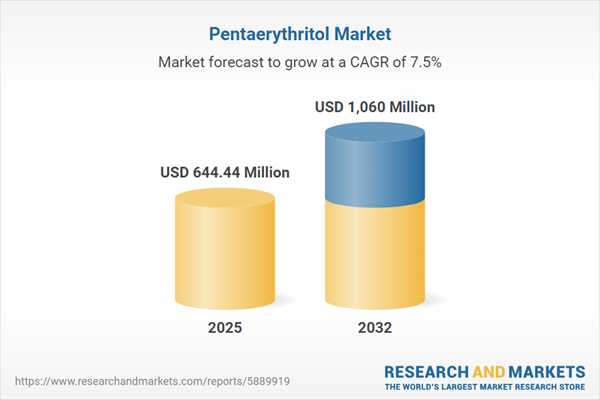Speak directly to the analyst to clarify any post sales queries you may have.
Pentaerythritol is evolving into a strategic cornerstone for manufacturers seeking operational efficiency, supply chain sustainability, and regulatory alignment across industries. Its chemical versatility, compatibility with emerging processes, and adaptability to fluctuating global conditions make it increasingly critical for organizations aspiring to maintain resilience and agility within complex market dynamics.
Pentaerythritol Market Snapshot
The global pentaerythritol market is demonstrating robust momentum, with a current valuation of USD 599.59 million in 2024 and expected growth to USD 644.44 million in 2025, underpinned by a 7.46% compound annual growth rate. By 2032, the market is anticipated to achieve a value of USD 1.06 billion. This upward trajectory is supported by targeted investments in process optimization and manufacturing resilience, as organizations respond to evolving regulatory demands, global disruptions, and an increased focus on sustainable approaches. Pentaerythritol is positioned as a facilitator for process innovation and quality enhancement across multiple manufacturing applications, sustaining its role as a preferred choice for sectors prioritizing operational excellence.
Pentaerythritol Market: Scope & Segmentation
- Application: Facilitates the performance of industrial adhesives, enhances alkyd resin curing, is integral to select explosive formulations, and serves as a foundational input for advanced plasticizers and lubricants utilized by automotive and general industrial manufacturers.
- End Use Industry: Supports critical operations within aerospace, defense, construction, coatings, lubricants, and automotive sectors. Addresses needs in both original equipment manufacturing and aftermarket contexts, aligning with distinct sourcing and regulatory requirements that shape procurement strategies and innovation pathways.
- Grade: Supplied in commercial, industrial, and technical grades to match various purity needs. These customizable options ensure compatibility with regional regulatory frameworks, facilitating seamless adoption in regulated sectors.
- Form: Available in both solid and liquid forms, pentaerythritol adapts to batch and continuous manufacturing environments, enhancing operational flexibility and adherence to diverse production specifications.
- Distribution Channel: Distributed through direct sourcing agreements and global logistics providers, ensuring reliable supply and consistent service for high-volume, geographically distributed buyers.
- Process: Production predominantly relies on the Aldol Condensation process, delivering products that satisfy the stringent certification criteria required for manufacturers prioritizing product consistency and integrity.
- Geographical Coverage: The market spans the Americas, EMEA, and Asia-Pacific, with high adoption seen in China, India, Japan, South Korea, and Australia. Shifting procurement models in EMEA and vibrant activity across Asia-Pacific directly impact regional supply chain approaches.
- Leading Companies: This industry features major players such as BASF SE, Mitsubishi Chemical Corporation, Ube Industries Ltd., AlzChem Group AG, Perstorp Holding AB, Eastman Chemical Company, JNC Corporation, Yantai Wanhua Chemical Group Co., Ltd., Jilin Chemical Industrial Co., Ltd., and Shandong Haili Chemical Co., Ltd., all actively advancing global standards and product capabilities.
Pentaerythritol Market: Key Takeaways
- Sustainable manufacturing initiatives are accelerating, with leading producers embedding emission-reduction and eco-centric practices throughout their supply chains to align with stakeholder expectations and regulatory frameworks.
- The integration of biobased and renewable feedstocks has increased resilience and diversity in raw material sourcing, stabilizing long-term procurement strategies despite unpredictable supply shocks.
- Markets enforcing stricter compliance, particularly across EMEA, are prompting manufacturers to implement digital monitoring systems and traceability solutions to maintain adherence and streamline processes.
- Ongoing demand surges in Asia-Pacific are reshaping regional manufacturing footprints and influencing how companies diversify their procurement models for greater security and responsiveness.
- Collaborative research and development activities among industry leaders are driving up purity benchmarks, enabling new product grades and expanding pentaerythritol’s scope of applications in high-precision and high-performance sectors.
Tariff Impact
Recent United States tariff adjustments are reshaping sourcing strategies for pentaerythritol producers in Asia and Europe. In response, manufacturers are reinforcing localized sourcing networks and structuring new inter-regional supply alliances. These measures facilitate greater agility, helping organizations optimize supplier portfolios and adopt flexible supply models amidst ongoing changes in trade policy.
Methodology & Data Sources
This research integrates insights from direct engagement with industry leaders, a review of trade publications, in-depth examination of regulatory material, and analysis of intellectual property data. The triangulation of these information streams ensures the delivery of actionable, reliable intelligence for senior industry professionals managing procurement and production portfolios.
Why This Report Matters
- Equips executives to navigate regulatory changes and embed sustainable strategies in pentaerythritol-centric manufacturing operations.
- Enhances risk management, facilitates data-driven strategic positioning, and supports innovation planning for stakeholders confronting sourcing complexities and competitive pressures.
- Delivers critical insights to procurement, production, and R&D leaders, enabling timely adaptation to evolving technologies and emerging industry trends.
Conclusion
This report consolidates timely, impactful insights, supporting decision-makers as they prioritize agility, ensure supply resilience, and advance their organization’s competitive advantage within the dynamic pentaerythritol market.
Additional Product Information:
- Purchase of this report includes 1 year online access with quarterly updates.
- This report can be updated on request. Please contact our Customer Experience team using the Ask a Question widget on our website.
Table of Contents
3. Executive Summary
4. Market Overview
7. Cumulative Impact of Artificial Intelligence 2025
Companies Mentioned
The companies profiled in this Pentaerythritol market report include:- BASF SE
- Mitsubishi Chemical Corporation
- Ube Industries, Ltd.
- AlzChem Group AG
- Perstorp Holding AB
- Eastman Chemical Company
- JNC Corporation
- Yantai Wanhua Chemical Group Co., Ltd.
- Jilin Chemical Industrial Co., Ltd.
- Shandong Haili Chemical Co., Ltd.
Table Information
| Report Attribute | Details |
|---|---|
| No. of Pages | 181 |
| Published | November 2025 |
| Forecast Period | 2025 - 2032 |
| Estimated Market Value ( USD | $ 644.44 Million |
| Forecasted Market Value ( USD | $ 1060 Million |
| Compound Annual Growth Rate | 7.4% |
| Regions Covered | Global |
| No. of Companies Mentioned | 11 |









